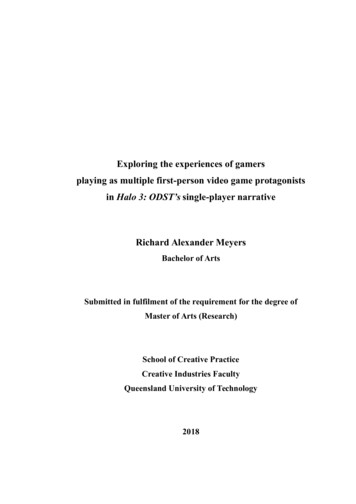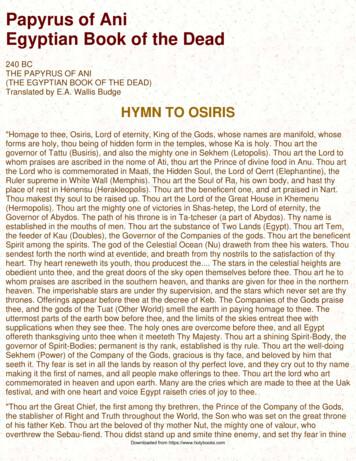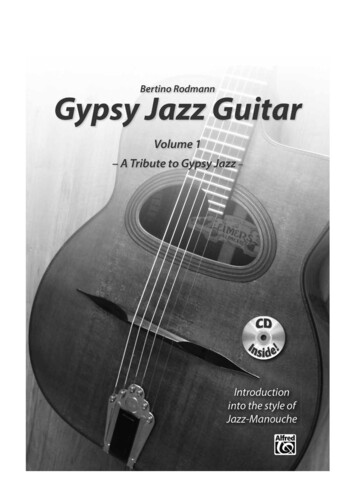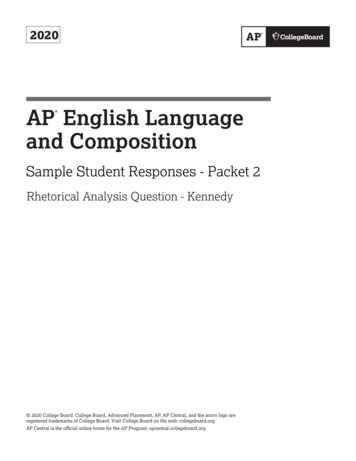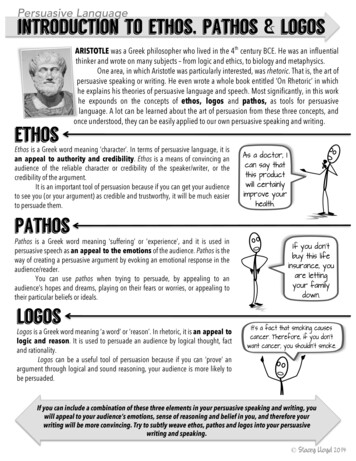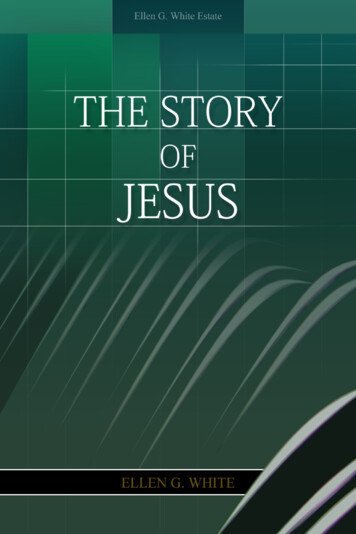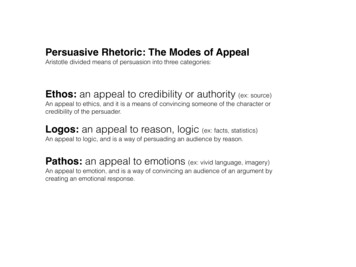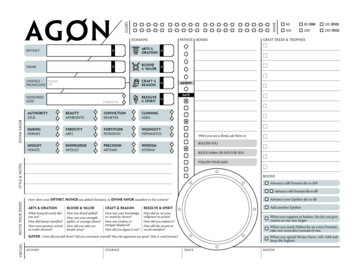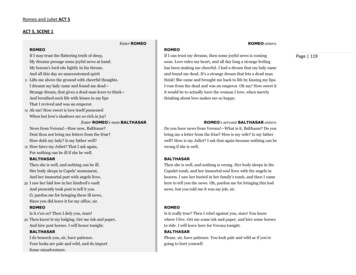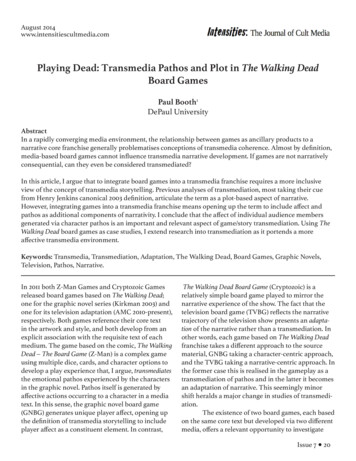
Transcription
August 2014www.intensitiescultmedia.comPlaying Dead: Transmedia Pathos and Plot in The Walking DeadBoard GamesPaul Booth1DePaul UniversityAbstractIn a rapidly converging media environment, the relationship between games as ancillary products to anarrative core franchise generally problematises conceptions of transmedia coherence. Almost by definition,media-based board games cannot influence transmedia narrative development. If games are not narrativelyconsequential, can they even be considered transmediated?In this article, I argue that to integrate board games into a transmedia franchise requires a more inclusiveview of the concept of transmedia storytelling. Previous analyses of transmediation, most taking their cuefrom Henry Jenkins canonical 2003 definition, articulate the term as a plot-based aspect of narrative.However, integrating games into a transmedia franchise means opening up the term to include affect andpathos as additional components of narrativity. I conclude that the affect of individual audience membersgenerated via character pathos is an important and relevant aspect of game/story transmediation. Using TheWalking Dead board games as case studies, I extend research into transmediation as it portends a moreaffective transmedia environment.Keywords: Transmedia, Transmediation, Adaptation, The Walking Dead, Board Games, Graphic Novels,Television, Pathos, Narrative.In 2011 both Z-Man Games and Cryptozoic Gamesreleased board games based on The Walking Dead;one for the graphic novel series (Kirkman 2003) andone for its television adaptation (AMC 2010-present),respectively. Both games reference their core textin the artwork and style, and both develop from anexplicit association with the requisite text of eachmedium. The game based on the comic, The WalkingDead – The Board Game (Z-Man) is a complex gameusing multiple dice, cards, and character options todevelop a play experience that, I argue, transmediatesthe emotional pathos experienced by the charactersin the graphic novel. Pathos itself is generated byaffective actions occurring to a character in a mediatext. In this sense, the graphic novel board game(GNBG) generates unique player affect, opening upthe definition of transmedia storytelling to includeplayer affect as a constituent element. In contrast,The Walking Dead Board Game (Cryptozoic) is arelatively simple board game played to mirror thenarrative experience of the show. The fact that thetelevision board game (TVBG) reflects the narrativetrajectory of the television show presents an adaptation of the narrative rather than a transmediation. Inother words, each game based on The Walking Deadfranchise takes a different approach to the sourcematerial, GNBG taking a character-centric approach,and the TVBG taking a narrative-centric approach. Inthe former case this is realised in the gameplay as atransmediation of pathos and in the latter it becomesan adaptation of narrative. This seemingly minorshift heralds a major change in studies of transmediation.The existence of two board games, each basedon the same core text but developed via two differentmedia, offers a relevant opportunity to investigateIssue 7 20
BoothPlaying Deadalternate versions of transmediation within nominally similar media texts. As I will go on to show inthis article, transmediation (the spread of uniquenarrative information throughout multiple mediatexts) and adaptation (the mirrored translation ofone media text into a different medium) both reflect similar concerns when it comes to board gameversions. Transmediation of games requires both theactive participation of the audience as well as recognition of key attributes of the core medium. In otherwords, the players of the game must actively generatenarrative meaning, but that meaning becomes basedon the particular affective experience of experiencingthe original text. This process relies on a conceptionof transmedia that develops interactively from bothauthor and audience, both creator and player.In literature about transmedia, we are encouraged to see it through a thoroughly plot- orstory-oriented perspective. Yet, a structural analysisof narratives reveals that different aspects of a narrative can be transmediated in different ways. Some ofthese aspects include static existents, like character,setting, or plot. Other aspects would fall under whatMarie-Laure Ryan (2012) calls dynamic categories, including the development of character relationships.For example, Christy Dena (2004) notes that a ‘storyworld’ role in cross-media franchises might developa character more thoroughly than a core text wouldhave time for. Television scholar Jason Mittell (201213: 48–56) has shown how different types of transmediation can function in television texts, includingwhat he terms ‘What Is’ and ‘What If’ transmedia ontelevision. ‘What Is’ tend to focus on expanding thestoryworld through augmentation, while ‘What If’tends to deepen the world as it already exists throughparatextual media context. Although both The Walking Dead board games exemplify Mittell’s conceptionof ‘What If’ transmedia stories, the comics-basedgame deepens the world through pathos while theTV-based game deepens the world through plot. Bothgames play on their connections to their core text,but do so in radically different ways.By participating in the game, the player/character experiences the level of pathos engendered byThe Walking Dead. In this article, I’m using the term‘pathos’ to refer to the emotional appeal that a textcan make to its reader. Both The Walking Dead texts,television show and graphic novel, create specific appeals to audience emotion. But each game based onthose texts approaches this level of pathos differently,and the relationship between the players and thecharacters become less invested in the overall Walking Dead narrative and more invested in the relationship between the players/characters themselves. Tobe an effective survivor, one must be part of and apartfrom the group. The players find themselves discovering that same sense of purpose. This is transmedia,but it’s not a general transmediated narrative – it’sa transmediation of affect, of deep and experientialemotion.I will argue, through analyses of the games’mechanics, character interaction, and artwork,that to exist in a transmediated relationship withthe core text, board games must not adapt plot, butrather must transmediate pathos. First, I will discusstransmediation as it has traditionally been appliedto narrative. In trying to transmediate the televisionnarrative, the TVBG ends up relegating the character-based affect generated by the television series infavour of focussing on plot-driven narrative adaptation. Then, I will discuss what I term ‘transmediapathos’, an emotional connection between transmediated texts, as it applies to the graphic novel andthe game based on it. In its attempts to transmediatepathos, the GNBG develops gameplay affect. I amdefining ‘affect’ here as the way that emotions aregenerated through the game. In other words, thegame based on the comic does not replicate a narrative situation, but rather places the player in the samesituations and with the same type of pathos as thecomic book characters.Transmedia and AdaptationLicensed board games based on or adaptedfrom previous media entities tend to be perceivednegatively. David Parlett, author of The Oxford Historyof Board Games (1999: 7), describes them quite pejoratively: ‘essentially trivial, ephemeral, mind-numbing, and ultimately [of a] soul destroying degree ofworthlessness’. Botermans, Burrett, van Delft, andvan Splunteren, in their encyclopaedic The World ofGames disregard the entire genre, writing that ‘theyare readily available commercially and rules of playare always included in the game’ (1987: 180). OftenIssue 7 21
BoothPlaying Deadperceived as synergist means of capitalising on thepopularity of a blockbuster film or popular televisionshow, board games based on media products exist ina more complex relationship with the main text thanother ancillary products do – they both problematiseand exemplify the relationship between media culture and reception strategies surrounding the maintext. Derek Johnson (2013) argues that while this typeof media franchising, an industrial process by whicha media text may be replicated across multiple cultural contexts, may be looked down upon at times, itis also the result of longstanding economic concerns:the existence of a popular media text makes it readymade for franchising through ancillary products likeboard games. Johnson’s analysis of media franchisinginvestigates these industrial and economic shifts; incontrast, I hope to explicate some aesthetic and textual concerns of ludic franchises.Specifically, by examining the tension between transmediation and adaptation within boardgame franchising, I hope to develop new ways ofunderstanding instances of ludic variation of a mediatext. Transmediation describes the spread of uniquenarrative information throughout multiple mediaoutlets. That is, one story is dispersed across multipleoutlets, so that only by encountering multiple mediacan one story unfold completely. The two WalkingDead board games overtly problematise narrativecoherence, but they also expand, deepen, and augment the narrative world through individual playerassociations with the core text. Yet, narrative is itselfcomposed of many attributes, and detailed investigation of those attributes may reveal the many andvaried ways that texts can cohere in a transmediatedfashion, for example, through audience participation, emotion, and interactivity. As Edward Branigan(1992: 17–20) notes, viewer emotional response to anarrative often develops from interpreting multiple(and nonlinear) associations between these dynamicelements. For example, in The Walking Dead graphic novel, the character of Jim becomes emotionallyrelevant (and thus using affect to generate pathos)because the story of his family – killed in front of himby zombies at the start of the outbreak – deepens andextends his past into his present (see also Zakowski2014). As I will show, the two Walking Dead boardgames use different mechanisms, including gamemechanics, character identification, and aestheticconnection, to generate narrative affect through thegameplay and increase player pathos.In traditional interpretations of transmediation, media scholars have tended to examine theseoutlets’ relationships as based in narrative storytelling. Although often associated with digital media(Booth 2010; Clarke 2013; Evans 2011; Gillan 2010; Jenkins 2006; Jenkins, Ford, & Green 2013), transmediation can also be traced to Greek myths and Biblicalstories as well as literature like Cervantes’ Don Quixote (Ryan 2012) and Lovecraft’s Cthulhu mythos (Price2009). The term ‘transmedia storytelling’ was firstposited by Henry Jenkins (2003: 3) to describe a narrative network where ‘integral elements of a fictionget dispersed systematically across multiple deliverychannels for the purpose of creating a unified andcoordinated entertainment experience’. As he later(2006: 95–96) writes in his influential definition:In the ideal form of transmedia storytelling, eachmedium does what it does best—so that a storymight be introduced in a film, expanded throughtelevision, novels, and comics, and its world mightbe explored and experienced through game play.Each franchise entry needs to be self-containedenough to enable autonomous consumption. Thatis, you don’t need to have seen the film to enjoy thegame and vice-versa.Narrative scholar Marie-Laure Ryan (2012:3–4) has described two different types of transmediastorytelling. ‘Snowball’ storytelling consists of a corenarrative that becomes so popular – e.g., Harry Potter,Lord of the Rings – that it inspires multiple productsto be created after its release. The Walking Dead as afranchise fits into this schema, as the original comic(first published in 2003) was not designed as a transmedia from the get-go, but slowly added additionalproducts as it developed. Robert Kirkman’s comicThe Walking Dead (2003-present) details a post-apocalyptic world from the vantage point of a number ofsurvivors of a zombie plague. The comic’s popularitywas ensured in 2010 when Frank Darabont developedit into the highly-rated cable television series (2010–present). The Walking Dead television series is quitedeliberately an adaptation of the graphic novel, asevidenced by the first season which follows the firstIssue 7 22
BoothPlaying Deadfew issues of the comic relatively closely, although asFischer (2011) describes, there are important differences, like the development of Shane’s character, thatshape our understanding of each (see also Jenkins2013). As it has progressed, the show’s narrative hasdiverged from the comic’s more and more.Transmedia narratives that are deliberatelydesigned to use multi-media from the start, or whatRyan calls ‘system’ storytelling, often are versions ofalternate reality games, which depend on active player interaction (see also Abba 2009). Both types of narratives involve transmedia extensions, or ‘elements dispersed across media and which fans have tocollect in order to recreate an encyclopaedic knowledge’ of the story (Bourdaa 2013: 5). The Walking Deadboard games are complicated extensions to transmedia franchises, as they play what Christy Dena (2004:10) might call a ‘storyworld role’, or the sense thatthey do not provide a ‘primary source of informationabout characters, setting’ nor does it ‘play a directrole in the unfolding plot’. Rather, these storyworldtexts ‘allow the fictional world to be accessed in thereal world through character identification’. In short,The Walking Dead games generate affect towardscharacters through player interaction, developing theworld rather than the original narratives.As corollary of transmedia storytelling, adaptation describes how one narrative is translated fromone medium to another. In other words, it is not onenarrative told through multiple channels, but rather one narrative mirrored in a different medium. Ineffect, the narrative is doubled (with the caveat thatany shift in medium signals some original material).An adaptation, as film critic Dudley Andrews (1984:96) describes, remakes and matches an original text’s‘sign system to prior achievement in some other system’. Adaptation is the translation and reproductionfrom one system to another, what Linda Hutcheon(2013: 3) describes as ‘stories taken from elsewhere,not invented anew’. But just because the story maybe borrowed, doesn’t mean the adaptation necessarily lacks originality: according to Cartmell (2010:20), adaptation will ‘rewrite the story for a particularaudience’. Part of the pleasure of adaptation comes,Hutcheon argues, from ‘repetition with variation,from the comfort of ritual combined with thepiquancy of surprise’ (2013: 4). In other words,adaptation differs from transmediation in the factthat an audience member of an adapted story mayfind new elements to a familiar plot, but with transmediation, will find new elements with each mediumshift.In the case of The Walking Dead board game,for example, the pleasure of adaptation lies in notingspecific aesthetic similarities as well as recognisingmoments of balance between adherence to a narrative and departure from it. We recognise familiarcharacters and scenes – an image of Carl on a cardor a scene of the protagonists attacking zombies – asan aesthetic connection to the original text, but thegame play mechanics allow us to play with that narrative world in ways unanticipated in the original storyworld. In the GNBG we can ever travel to locations,like the airport, that the characters in the graphicnovel haven’t. A ludic adaptation can never reproduce precisely the ‘sign system’ of the original narrative but this does not have to be a limitation; rather,elements within that sign system that themselvessignify larger narrative developments can be adapted. Indeed, Scolari (2009: 587) notes that transmediastorytelling ‘is not just an adaptation from one media[sic] to another. The story that the comics tell is notthe same as that told on television or in cinema’. Andas Brookey (2010) argues, the adaptation of film to avideo game rarely matches the style and tone of theoriginal. Board games make adaptation even moredifficult – while a board game can include the samerepresentations of characters, locations, and propsas the original text, it will rarely match precisely theevents as they occurred on screen or on the page,given the fluidity of gameplay. And the two WalkingDead games make this adaptation more different still,as the TVBG is itself an adaptation of an adaptation.Board games are rarely analysed in terms oftransmediation, although many canonical definitions of transmedia describe video games as one ofthe main nodes in the storytelling network (Jenkins2006; Gray 2010; Johnson 2013). Video games fit into atransmedia paradigm because they ‘fit within a mucholder tradition of spatial stories’ (Jenkins 2004: 122).This hyperdiegetic sense of narrative – that there is asense of more world than can be experienced in anyone text (Hills 2002) – fits the spatial organisation ofvideo games. As a text with vast environments andIssue 7 23
BoothPlaying Deadworlds for the characters (and the audience) toexplore (Gwenllian-Jones 2004), The Walking Deadfranchises have featured video game transmediaextensions and adaptations. Indeed, in 2012 TelltaleGames’ video game based on The Walking Dead franchise was released as a hyperdiegetic extension tothe series: it details the first few weeks of the zombieinfection (scenes both the television series and thegraphic novel have left deliberately vague). In contrast, the physicality of board games tends to limitthem to non-hyperdiegetic roles in narrative, as theexpansive world of video games (or of cult narrativesgenerally) are difficult to replicate in physical spaces.As Montola (2012: 314) notes, citing Pearce(2009), video games and other ‘virtual worlds havemore in common with ordinary life than with boardgames’. As Zagal, Rick, and Hsi (2006: 26) haveshown, while video games involve complex interaction with multiple technologies, contexts, and mechanics, ‘the nature of board games implies a transparency regarding the core mechanics of the gameand the way they are interrelated’ – a transparencythat makes unique changes to external narrativesdifficult. Yet, Zagal, Rick, and Hsi (2006: 28) actuallyuse board game mechanics to generalise about videogames, and it’s relevant that they focus specifically onan analysis of The Lord of the Rings board game – notseen in a transmediated relationship with the coretext, but rather as a ‘themed’ spin-off of the books.As seen in a connective relationship with a core text,board games can generate new dynamics within narrative interaction; as Wilson (2007: 91–92) illustrates,focusing on things that board games are good at,like face-to-face communication and tactility, allowsboard game designers to give each game a uniqueidentity, ‘a certain feel’. Transmediation allows individual texts to develop sections of the storyworld,each one ‘contributing to a larger narrative economy’(Jenkins 2004: 124).For Ryan (2012: 6), a storyworld transmediafranchise develops through a ‘static component thatprecedes the story, and a dynamic component thatcaptures its unfolding’. These static componentsinclude characters, existent items, rules, or other underlying existents. The dynamic components includephysical events that change the existents or mentalevents that give those existents significance. Staticelements remain stable from one text to another;Rick and Carl are two characters that will be in allversions of The Walking Dead. Dynamic componentscan change the trajectory of the particular iterationof the narrative within the specific text; in the comic,antagonist Shane dies very early on in the narrative, but in the TV show, Shane survives far into thesecond season. The dynamism of Shane’s existenceclarifies and separates the two iterations, lendingweight to Shane’s death in both.Translating a television series or a graphicnovel to board game form requires what Ryan (2012:3) notes is ‘transmedial adaptation’ – the use of thosestatic elements combined with interactively generated dynamic components. Both The Walking Deadboard games make use of static elements adaptedfrom the prerequisite text: main characters who haveto find supplies and clear locations of zombie infestation, encounters with the undead along the way. TheGNBG dynamic component is original to the game; itplaces those characters in new situations that furtherdevelop the affective relationship between the playerof the game and those characters, transmediatingthat text’s pathos. In contrast, the TVBG’s dynamiccomponent – the situations that each character/player encounters – mirrors moments from the televisionprogram. The TVBG does not develop its dynamicelements, instead focussing on reflecting the plot ofthe show.It is not my intent here to get mired in the‘narratologist/ludologist’ debate within game studies(see Aarseth 1997; Frasca 1999; Frasca 2003; Jenkins2004; Pearce 2004), which (in simplified form) tendsto examine games as either narratively-based orinherently play-based. Rather, I agree with Zimmerman (2004) in noting the ways both narrative andplay are deployed within games as being instructivein and of itself. As Ryan (2012: 25) writes about thetransmediation of Star Wars from film to game, ‘itsplot is one of countless stories that tell about a fightbetween good and evil. What makes the Star Warsstoryworld distinctive is not the plot but the setting’;in essence, transmediating board games replicatesetting but at the expense of plot altogether. As I willshow with The Walking Dead board games, such replication can indicate either transmediation or adaptation, depending on the relationship between theIssue 7 24
BoothPlaying Deadgame mechanics, character interaction, and appearance of the game.Walking Dead Zombies and Playing Walking DeadTo analyse both The Walking Dead boardgames, we must look at the participation of the gameplayers as part of the game experience. This is aninherently difficult proposition, as Montola (2012: 313)suggests:play is a temporary and ever-changing socialprocess that can only be analyzed as a whole inretrospect. Participants obtain different pieces ofinformation during the play, and no participantcan ever accumulate all the information related toa game.Yet, it is necessary to assume standard ‘play’ attributes in order to generalise about the mechanics ofthe games for the players. There are some standardelements in The Walking Dead that make this analysisslightly easier. The Walking Dead relies on audienceaffect, what Bishop (2011: 10) terms ‘dramatic pathos’,to engender a connection to the characters. Boththe comic and the television series reflect this, asBonansinga (2011: 55) notes: ‘the spiritual centre ofthe comic series – a human story laying out amid allthe gore – translates well to the intimate confines oftelevision’.On the surface, it would be relatively easyto ascribe value to one or the other games – it’s a‘good’ game because it is only sort of like the TVshow, but a ‘bad’ game if it is too much like the TVshow: the ‘uncanny valley’ of transmediation, orthe ‘pasted on theme’. Such determinations mightbe useful for a critical conversation about ludologyand the ‘ludological dissonance’ (Hocking 2007) thatnarrative-based games engender. However, it’s notmy intention to argue that one game is ‘better’ thanthe other; rather, evaluative judgments allow us toprobe deeper in the mechanisms of transmediationitself. After all, the effectiveness of transmediation asa concept must somehow relate to the effectivenessof transmediation as a narrative form, at its heart anevaluative construct.The generative process of game-based pathosemerges from player empathy for character.Empathy, itself a term reliant on the lexicographicaldevelopment of ‘pathos’, is what allows players tofeel emotion within a fictional world and for fictional characters. As Salen and Zimmerman (2006: 27)show, the complex relationship between game playerand game character generates affect in game playersby giving them ‘permission to play with identity’.This pathos translates particularly to the GNBG. Indeed, while many of the same characters are presentin both games, only the close connection betweenthe player and the character in the comic-based gameengenders a transmediation of affect. In other words,the GNBG generates transmedia pathos through thecharacter attributes and the player investment in theunfolding of the game.In order to examine the salient differencesbetween the two games, I will focus this analysis onthree elements: the gameplay mechanics, the player/character interactions within the game, and the artwork of the game. Through an investigation of theseelements, I’ll show how the GNBG functions throughtransmedia pathos and how the TVBG functionsthrough plot adaptation. The point of this comparison is to illustrate how transmediation can beenacted through board games, but only by tappinginto what Pearce (2005: 3) describes as ‘Aristoteliannotions of empathy’; in other words, how the player/viewer’s pathos connects to the characters’.MechanicsThe game mechanics of the GNBG allowfor creativity in how one plays the game throughmore random elements and more freedom to chooseoptions, in contrast to the TVBG, which focusesmore on replicating story experiences from the show.Through the gameplay mechanics, the GNBG’s individual player actions can affect the outcome of thegame. This allows players to become invested in theirown choices while not remaining tethered to the plotof the comic. In contrast, the TVBG offers a moreclosed system that limits player interactivity throughforced choice. This allows players to experience aset narrative, akin to watching a television episode.The freedom to make complex decisions within theGNBG encourages an affective relationship betweenplayers and characters, highlighting a transmediatedconnection with the original text. Conversely,Issue 7 25
BoothPlaying Deadthe TVBG features a more static, less interactivegame; players have fewer options and follow a morepre-determined route through the game. While notunusual for a mainstream board game, such dynamics encourage passivity in the players and engender acloser reflection to the original text.Specifically, the differences in the gameboardsthemselves offer a useful heuristic by which we canevaluate the mechanics of the game. In the GNBG,the gameboard is expansive and multi-spaced. Eachspace is hexagonal and players can move in any ofthe six directions (see Figure 1). Players can chooseto move up to three spaces at a time, or additionalsupplies allow more movement if deemed necessary.After moving off a space, however, zombies populatethat space, and the board gradually becomes filledwith the undead. The game is highly randomised,both in terms of objectives and in terms of gameplay.The players have thirteen objective locations, onlyfour of which are open at a time. As soon as onelocation is cleared of zombies, another is randomlyselected. When encountering zombies, players rollmultiple dice – sometimes as many as ten – in orderto defeat or survive the attack. Supplies can be foundthroughout the game, and can be used in multipleways. Additionally, players can interact with otherplayers in various ways – some randomly selectedcards force player interaction, either through fightingor through ethical decision-making. In one memorable moment from a game I recently played, my opponent drew a card that asked him to decide whetheror not I gained supplies – if I did, he would also getsupplies but I might be closer to winning. Players,however, can also cooperate, working together todefeat massive numbers of zombies, especially usefulwhen walking past the hoards created by the onesthat spawn on vacated spots. In short, at each point inthe game, players are encouraged to make decisionsthat not only impact their own character’s survival,but the survival of other players as well. Players canfollow multiple paths, and become invested in whatothers are doing. In no way does this mirror the narrative of the graphic novel – the specific scenes andadventures that take place in Kirkman’s books are notmentioned, and only the static elements of the seriesexist in the game. The dynamic elements are thosecreated by the players themselves, using their owndecision-making to affectively design their playFigure 1: Section of hexagonal gameboard for The Walking Dead graphic novelboard game. Image by Paul BoothIssue 7 26
BoothPlaying Deadexperience.The GNBG encourages players to revel intheir own created world of The Walking Dead, effectively transmediating the feeling that one gets fromthe comic. Following the exploits of the survivors ofthe zombie apocalypse, the graphic novel is moreakin to a melodramatic soap opera than to a horrorstory (Fischer 2011). For example, protagonist Rick isknocked unconscious before the zombie apocalypse,and awakens as it has already reached its zenith.Set out to find his family, he eventually finds themin the woods with a group of other survivors – hiswife having had an affair with his best friend, Shane.Although some of the narrative involves killingzombies, the majority of the graphic novels’ violencedepicts characters fighting against each other, as thecharacter Negan demonstrates with his barbed wirewrapped baseball bat. Other scenes depict charactersfalling in love with each other like Rick and Andrea(Bishop 2011), having intense sexual relationships,like Tyreese and Carol (Vossen 2013), and raisingchildren, like Rick and Carl (Steiger 2011). For example, the characters of Glenn and Maggie provide a lotof melodramatic story to follow, as they
Aug 03, 2014 · The Walking Dead as a franchise fits into this schema, as the original comic (first published in 2003) was not designed as a trans-media from the get-go, but slowly added additional products as it developed. Robert Kirkman’s comic The Walking Dead (2003-present) details a post

